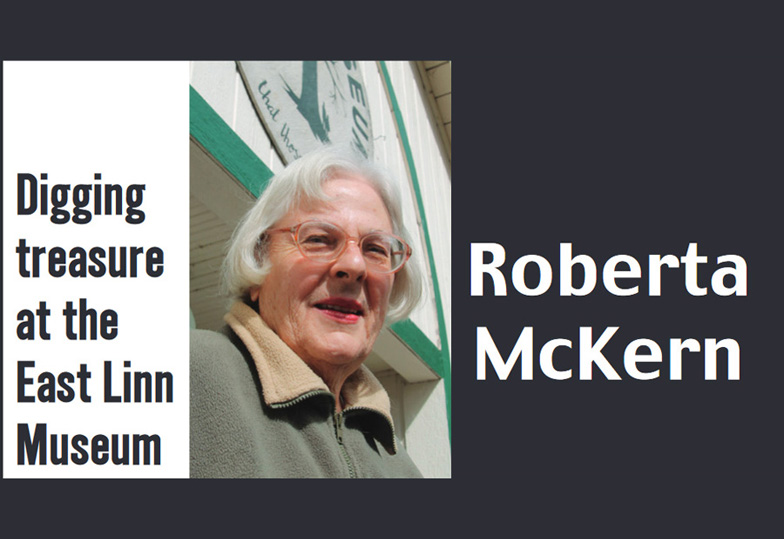By Roberta McKern
Lemonade has come to mind recently.
The time of year had something to do with it, as spring runs into summer with longer, warmer days.
Even when we’re past our youth, they bespeak expectations of traditional picnics and fairs in small nearby towns.
Some have been yearly events since the end of the 19th century, and we can only envision how they used to be. We don’t really know. What we have are confabulations from our own experiences and what we’ve come to believe from other accounts. Surely, once there were such times with peanuts, popcorn, Cracker Jacks and lots of lemonade – some of it pink – and there were always parades.
We think of a conversation after a parade. A representative of the Masons and Shriners had driven the “jitney,” a gaudy red, yellow and green vehicle of vintage age and many modifications, during the procession. The parade was ending, and the Shriner dozed off and on, watching for rain and waiting for the horse organizations to amble out of the roadway.
He recalled the festivals from his youth in the 20th century’s early years, when women dressed in white for summer. In their dresses, shoes and stockings, they would travel to the picnic grounds, where they’d carefully pick their way through mud churned up by horses, buggies and early automobiles. The men defied the mud, too. It seemed such an appropriate image from what we’d experienced ourselves.
And were the ladies, we wondered, bound for concession stands where, enveloped in big, white aprons, they doled out pieces of pie and cake and glassfuls of lemonade in the name of a church or fraternal order?
And, we can ask ourselves, did they always really serve lemonade?
In our time, soda pop had taken over. Why did lemonade seem such a treat? How much labor, on one hand, was required to make a dish pan or copper boiler full of it for a once-a-year occasion? Did strong men and boys do that work?
We’ve all made lemonade. It doesn’t take philosophy to do so. The recipe is simple: mix lemon juice with water, stir in sugar to taste, and the refreshing drink is ready – if there’s enough sugar.
Of course, lemons must be squeezed to produce that juice, and in the old days, sugar came in loaves or hardened together in sacks and had to be broken up.
Mail-order catalogs featured lemon squeezers, and the East Linn Museum has one. It’s not the glass kind we still use, which sits on a table. A cone rises in the middle, upon which we must press half a lemon and scrunch it around to extract juice, seeds and pulp. Purists pick out the seeds.
The metal one at the museum resembles a rounded pot combined with a nutcracker. The fruit could be an orange, lime or lemon. It gets into the bottom, which has a lip to pour the juice squeezed from the fruit. There’s a sort of plunger in the lid that fits into a lemon’s open half. When the handles come together, the squeeze is on. This is a high-class lemon squeezer, according to old Sears Roebuck catalogs. “A Yankee” good for juicing a bushel of lemons.
We have another lemonade souvenir, too: a beautiful emerald-green goblet with gilt trim. The 1895 Montgomery Ward catalog advertised water or lemonade sets that came with fancy glass pitchers with matching tumblers. The catalog offers eight different patterns in various hues. Our tumbler is the Croesus pattern, named after the wealthy King of Lydia because of its gold arabesques.

Many ladies in white summer dresses likely served lemonade from such sets, but with the Croesus tumbler as the museum’s sole example, we can guess that not many pieces of such attractive glass – whether we call them glasses, tumblers or goblets – survived.
The lemon squeezer and lemonade sets indicate how popular the beverage had become in the late 1800s.
We checked Wikipedia and were surprised to find a complete article on lemonade. Did Cleopatra serve it to her lovers, Julius Caesar and Mark Anthony? The Egyptians had something like it, but the Romans didn’t mention it, so, maybe not. Still, lemons have grown around the Mediterranean for thousands of years, and if Cleo lacked sugar, she could have used honey as a sweetener.
In some respects, Christopher Columbus helped boost the drink’s popularity with his 1492 discovery of the islands in the Caribbean Sea. He docked at Hispaniola, now the Dominican Republic and Haiti, and called the innumerable islands in the area the West Indies, figuring he’d hit India. He hadn’t, but in a few more decades both the West Indies and India would have one thing in common: the raising and refining of sugar cane.
Lemonade takes a lot of sugar. An old cookbook suggests a cup to three lemons per quart of water.
In 1402, sugar was nearly worth its weight in gold, and it wasn’t long before various European nations raced to claim sugar islands for themselves. They also tried different forms of enforced labor on their plantations because making sugar is labor-intensive. The Spanish, Dutch, English, French, Danish and Portuguese all traded in African slaves after employing indentured servants and enslaved American Indians first. One thing the African slaves had was some immunity to the deadly diseases they transported with them. Such is the bitter history of sugar.
The Spanish who settled in Cuba as well as much of the rest of the southern part of the New World brought lemons. The Arabs had introduced them in Spain when they spread Mohammedanism along the Mediterranean by fire and sword. Spanish conquistadors carried them to the New World, along with padres who spread lemons, limes and oranges as well as religion.
According to Wikipedia, lemons arrived in Paris in 1630. Lemonade became very popular in the city as sold by “limonadiers.” Honey was likely incorporated as a sweetener, but, ah, sugar was becoming increasingly available.
There’s some suggestion that the limonadiers’ product may have protected the Parisians from the Plague. Maybe not, but its medicinal value, at least regarding lemon juice, was later recognized by the great seaman Capt. James Cook when he circumnavigated the globe from east to west in the early part of the 18th century. Scurvy plagued ships’ crews on long voyages, and Cook promoted feeding the men fresh vegetables and fruits, and lemon juice. (Scurvy occurs due to a lack of vitamin C, and hard tack and salted pork didn’t suffice. Lemons, on the other hand, are a go-to.)
After Cook proved the need, Parliament passed a law dictating giving each crew member one ounce of lemon or lime juice per day on long voyages. An enterprising entrepreneur planted lime plantations on the West Indian island of Montserrat and earned a monopoly on selling lime juice to the British navy. That’s why English sailors became known as limeys. Some, however, were likely lemonies. This was according to the 1892 Encyclopedia Britannica at the museum.
Well, almost. Adding sugar and water would have given the sailors lemonade.
We learn about Lemonade Lucy and circus lemonade in Carrie Tatro’s “The Fascinating History of Lemonade.” We’ve met Lemonade Lucy before. She was the wife of our 19th U.S. president, Rutherford B. Hayes, a pretty honest president in a dishonest time.
Hayes gained his office right after Ulysses S. Grant’s post-Civil War administration through finagling. His Democratic opponent, Samuel J. Tilden, won the popular vote. Some electoral college votes remained undecided, and the Republicans cut a deal with vacillating Southern representatives: Elect Hayes to end the very unpopular Reconstruction of the South. Naturally, he got the deciding vote. The South went back to its old elitism, Jim Crow moved in and Rutherford B. Hayes retired after one term. However, during his tenure, serving alcohol in the White House was banned. Lucy earned either the blame or the praise. Hence, she was called “Lemonade Lucy.”
Also, it seems that Rutherford B. hoped to court the Prohibition Party. According to another story sometimes told in history classes, diners at state dinners need not feel entirely dejected. Among the fruits offered after the meal were plates of oranges injected with rum.
We have some doubt about that tale, just as history doubts two versions of how the circus gained pink lemonade. According to one story, red cinnamon candies accidentally fell into a batch of lemonade. Another involves a vendor who ran out of water and grabbed the first available bucketful he saw. Alas, a lady performer, maybe a bareback rider, had been soaking her red tights, and we all know how red fades. Hence, pink lemonade. In both instances, it sold well, inaugurating the pink-lemonade craze, which along with peanuts, popcorn and Cracker Jacks has become art of the mythical land of fairs, picnics and other festivals.
Although some of the old cookbooks, like the museum’s copy of “The White House Cookbook,” mention ways to enchant lemonade’s charm, coloring it pink is not one of them. Adding a half-teaspoon of bicarbonate of soda is. The soda acts with the lemon’s acids, citric for vitamin C being one. Carbon dioxide is released, and the lemonade fizzes.
Another suggestion involves just adding lemon extract, which is made of lemon oil pressed from the rinds and about 83% alcohol, according to a label on a package.
Which brings us to a lemonade story in keeping with our neck of the woods, that of the would-be inebriated logger caught in a logging camp without alcohol. In the dry old days, men drank bitters as medicinals, but the highly alcoholic bitters had likely run out. A desperate logger’s final recourse was to break into the cook shack and sample vanilla or lemon extract. Vanilla might have been the first choice, but lemon ran a good second.
Speaking of the dry old days, we checked for a song about lemonade in the museum’s reference room. Apparently, though, all the girls who sang about “Lips that touch wine will never touch mine” concentrated on pure, cold water.
When we think of the past and lemonade, we begin to wonder: Did we ever drink as much as we believed we did? Cartoonists have given mythic qualities to kids selling lemonade at 5, 10 and 25 cents (and more) per glass from sidewalk stands, but they never seemed to be near us.
And how was lemonade sold at concession stands before the invention of paper cups? Modern ones didn’t arrive until the 20th century. Even at church events or ones involving some fraternal order or social organizations, we drank lemonade from punch cups or tumblers more modest than the museum’s green and gold Croesus glass. It seemed a terrible waste to buy paper drinking vessels, use them once and then toss them away.
Before paper cups, people often shared common dippers, cups and glasses, a good way to spread contagion and belie lemonade’s purported medicinal qualities. Soda pop came in bottles, which is one reason Queen Lemonade lost her crown. Now it’s made a comeback, and it comes in bottles, too. In various tints, hard lemonade contains alcohol. We can still make our own mix with lemons, sugar and water, or we can buy ready-made sweetened with Midwestern corn syrup.
It wasn’t Lemonade Lucy or the circus that really promoted lemonade in this country in its mystical 19th-century peak. No, a combination of railroads, refrigerator cars abetting the shipment of fruits and vegetables as well as meat and the proliferation of lemon groves in Florida, California and Hawaii made the delicious and refreshing drink more available: the commercial network with cheap sugar thrown in.
As a product of progress and urbanization, lemonade’s become a part of nostalgia. It evokes images we can’t really remember because they were before our lifetimes, but we can remember what someone like the old Shiner in the gaudily painted “jitney” once said about seeing ladies in summer white dresses, shoes, and stockings at a small-town fete with peanuts, popcorn, Cracker Jacks and lots of lemonade available. We may recall an old song that supports the drink’s mythic quality: “Oh, the buzzing of the bees in the peppermint trees round the soda water fountains where the lemonade springs and the bluebird sings on the big Rock Candy Mountain.” It’s now lemonade time.
We want to thank Robert Rosé for once again joining us for a rock identification day. He has agreed to come again in September.
The museum is collecting now for the July yard sale. Items may be brought between 11 a.m. and 4 p.m. Thursdays, Fridays and Saturdays at 746 Long Street. Volunteers in general are very welcome, especially now that we’ve had another retirement. Yard-sale help is appreciated, too.





